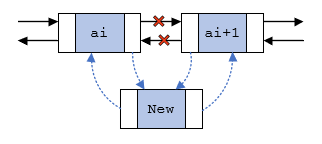本文最后更新于212 天前,其中的信息可能已经过时,如有错误请发送邮件到zhangweihao22@outlook.com
简介
此模块为学校数据结构必修课学习内容的记录与分享
全文大体分为一下几个部分
- 模块解释
- 可视化GIF合集
- 整体复现
- 最终结果
模块解释
定义双向链表
typedef struct DoubleLinkedNode {
char data;
struct DoubleLinkedNode *previous;
struct DoubleLinkedNode *next;
} DLNode, *DLNodePtr;初始化节点
DLNodePtr InitLinkList () {
DLNodePtr temphead = (DLNodePtr)malloc(sizeof(DLNode));
temphead->data = '\0';
temphead->previous = NULL;
temphead->next = NULL;
return temphead;
}打印双向链表数据
从头节点开始打印节点内数值
void PrintList(DLNodePtr ParaHeader) {
DLNodePtr temp = ParaHeader->next;
while (temp != NULL) {
printf("%c ", temp->data);
temp = temp->next;
}
printf("\n");
}节点插入
在指定位置插入节点
void InsertElement(DLNodePtr ParaHeader, char ParaData, int ParaPosition) {
DLNodePtr p, q, NewNode;
p = ParaHeader;
for (int i = 0; i < ParaPosition; i++) {
p = p->next;
if(p == NULL) {
printf("The position %d is beyond the scope of the list.", ParaPosition);
return;
}
}
q = p->next;
NewNode = (DLNodePtr)malloc(sizeof(DLNode));
NewNode->data = ParaData;
p->next = NewNode;
NewNode->previous = p;
NewNode->next = q;
// NewNode->next = p->next;
// 大意写成这样,导致了节点循环调用,导致程序崩溃
// 如果p是最后一个节点,那么q为NULL,就没有节点指向新节点
if(q != NULL) {
q->previous = NewNode;
}
}节点删除
删除含有指定数据的节点
void DeleteElement(DLNodePtr ParaHeader, char ParaData) {
// p 为要删除节点前的节点
// DeletNode 为待删除的节点
// r 为待删除节点后的节点
DLNodePtr p, DeletNode, r;
p = ParaHeader;
while ((p->next != NULL) && (p->next->data != ParaData)) {
p = p->next;
}
// 确保后面是目标节点
if(p->next == NULL) {
printf("The element %c is not in the list.", ParaData);
return;
}
DeletNode = p->next;
r = DeletNode->next;
p->next = r;
if(r != NULL) {
r->previous = p;
}
free(DeletNode);
return;
}输出地址信息
打印链表各节点地址信息
void PrintMemory(DLNodePtr ParaHeader) {
DLNodePtr temp = ParaHeader->next;
int i = 0;
while (temp != NULL) {
printf("The %d node is %c | the previous address is %ld the adress is %ld the next address is %ld\n", i, temp->data, temp->previous, temp, temp->next);
temp = temp->next;
i++;
}
}测试函数
void TestAll () {
DLNodePtr tempList = InitLinkList();
printf("Before the insert : \n");
PrintList(tempList);
InsertElement(tempList, 'H', 0);
InsertElement(tempList, 'e', 1);
InsertElement(tempList, 'l', 2);
InsertElement(tempList, 'l', 3);
InsertElement(tempList, 'o', 4);
InsertElement(tempList, '!', 5);
printf("After the insert : \n");
PrintList(tempList);
DeleteElement(tempList, 'e');
DeleteElement(tempList, 'a');
DeleteElement(tempList, 'o');
printf("After the delete : \n");
PrintList(tempList);
InsertElement(tempList, 'o', 1);
printf("After the insert : \n");
PrintList(tempList);
PrintMemory(tempList);
}main 函数
int main(){
TestAll();
return 0;
}可视化GIF合集
由于双向链表只是在单链表基础上增加了一个 previous 前向指针,其它的处理思路是一致的,因此就不放GIF动画,仅补充对应的图例
主要是我只找到循环双向链表的GIF,哈哈
双向链表结构形式

添加节点

注意在最后节点进行添加的特殊情况
删除节点

注意删除最后节点的特殊情况
整体复现
#include<stdio.h>
#include<malloc.h>
// 双向链表节点定义
typedef struct DoubleLinkedNode {
char data;
struct DoubleLinkedNode *previous;
struct DoubleLinkedNode *next;
} DLNode, *DLNodePtr;
// 初始化节点
DLNodePtr InitLinkList () {
DLNodePtr temphead = (DLNodePtr)malloc(sizeof(DLNode));
temphead->data = '\0';
temphead->previous = NULL;
temphead->next = NULL;
return temphead;
}
// 从头节点开始打印节点内数值
void PrintList(DLNodePtr ParaHeader) {
DLNodePtr temp = ParaHeader->next;
while (temp != NULL) {
printf("%c ", temp->data);
temp = temp->next;
}
printf("\n");
}
// 在指定位置插入节点
void InsertElement(DLNodePtr ParaHeader, char ParaData, int ParaPosition) {
DLNodePtr p, q, NewNode;
p = ParaHeader;
for (int i = 0; i < ParaPosition; i++) {
p = p->next;
if(p == NULL) {
printf("The position %d is beyond the scope of the list.", ParaPosition);
return;
}
}
q = p->next;
NewNode = (DLNodePtr)malloc(sizeof(DLNode));
NewNode->data = ParaData;
p->next = NewNode;
NewNode->previous = p;
NewNode->next = q;
// NewNode->next = p->next;
// 大意写成这样,导致了节点循环调用,导致程序崩溃
// 如果p是最后一个节点,那么q为NULL,就没有节点指向新节点
if(q != NULL) {
q->previous = NewNode;
}
}
// 删除含有指定元素的节点
void DeleteElement(DLNodePtr ParaHeader, char ParaData) {
// p 为要删除节点前的节点
// DeletNode 为待删除的节点
// r 为待删除节点后的节点
DLNodePtr p, DeletNode, r;
p = ParaHeader;
while ((p->next != NULL) && (p->next->data != ParaData)) {
p = p->next;
}
// 确保后面是目标节点
if(p->next == NULL) {
printf("The element %c is not in the list.", ParaData);
return;
}
DeletNode = p->next;
r = DeletNode->next;
p->next = r;
if(r != NULL) {
r->previous = p;
}
free(DeletNode);
return;
}
void PrintMemory(DLNodePtr ParaHeader) {
DLNodePtr temp = ParaHeader->next;
int i = 0;
while (temp != NULL) {
printf("The %d node is %c | the previous address is %ld the adress is %ld the next address is %ld\n", i, temp->data, temp->previous, temp, temp->next);
temp = temp->next;
i++;
}
}
void TestAll () {
DLNodePtr tempList = InitLinkList();
printf("Before the insert : \n");
PrintList(tempList);
InsertElement(tempList, 'H', 0);
InsertElement(tempList, 'e', 1);
InsertElement(tempList, 'l', 2);
InsertElement(tempList, 'l', 3);
InsertElement(tempList, 'o', 4);
InsertElement(tempList, '!', 5);
printf("After the insert : \n");
PrintList(tempList);
DeleteElement(tempList, 'e');
DeleteElement(tempList, 'a');
DeleteElement(tempList, 'o');
printf("After the delete : \n");
PrintList(tempList);
InsertElement(tempList, 'o', 1);
printf("After the insert : \n");
PrintList(tempList);
PrintMemory(tempList);
}
int main(){
TestAll();
return 0;
}输出结果
PS D:\a_study\code_vs\DataStructure\DoubleLinkedNode> gcc -o kernel code.cpp
PS D:\a_study\code_vs\DataStructure\DoubleLinkedNode> ./kernel
Before the insert :
After the insert :
H e l l o !
The element a is not in the list.After the delete :
H l l !
After the insert :
H o l l !
The 0 node is H | the previous address is 12065536 the adress is 12069680 the next address is 12091408
The 1 node is o | the previous address is 12069680 the adress is 12091408 the next address is 12091344
The 2 node is l | the previous address is 12091408 the adress is 12091344 the next address is 12091376
The 3 node is l | the previous address is 12091344 the adress is 12091376 the next address is 12091440
The 4 node is ! | the previous address is 12091376 the adress is 12091440 the next address is 0可以看见,如此(previous address – address – next address)排列下的链表节点地址具有明显的线性对应特点,反映其优美的对应关系
过程记录
- 复现代码
- 发现错误【指针指向问题】
- 修改错误
- 优化输出结果
- 迁移文章
Points
最后节点的判断
因为双向链表一个节点(有两个指针)会储存前后节点信息,在对节点处理的时候,要注意对前后节点两个指针进行处理
例如,在进行 delete 操作时,若删除最后一个节点,则需要把倒数第二个节点的 next 指针赋值为 NULL,并 free 掉最后一个节点。
Thinking
what – 什么是双向链表, 在现实世界中有哪些双向链表的例子?
双向链表是具有前后节点信息的链表
浏览器浏览记录(可以进行后退和前进操作)
文本编辑中的前后撤回操作
音乐播放器列表
why – 有了单链表, 为什么还要引入双向链表?
双向链表具有更高的灵活性,更容易地在任意位置插入或删除结点,无需从头节点开始遍历
what – 对双向链表进行操作的时候, 容易出现哪些错误?
- 访问越界
- 指针更新错误(造成节点循环)
- 内存泄漏







